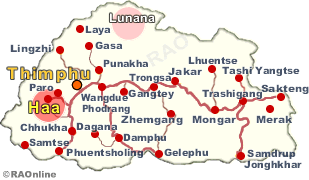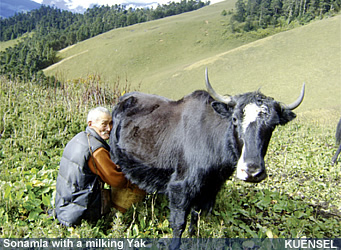 |
Bhutan's
Economy: Yak Farming |
 |
Bhutan Information |
|
 |
| Agriculture |
|
|
Yak Herding - A vanishing way of life
|

|
 |
Once the mainstay of the Haa valley, its numbers are now on the decline
Yak Herding: For Kesang, 59, of Bji gewog in Haa, handling the yak, an essential source livelihood for nomadic communities in the high mountains, is becoming less of a hassle, because of a rapid decrease in its population over the years.
|
"Development activities, insufficient labour, less support for herding communities, to the younger generation opting out, with more children attending schools, have contributed to the decline," Kesang said.
Herding yaks since a 16-year-old, Kesang today has about 40 yaks, less than half of what she owned a decade ago. "With my kids going to school, and not having enough time and manpower, I started selling my yaks to herders in Soe Yaksa in Tshento gewog in Paro," she said, adding that one has to walk for days to the grazing grounds.
With altitudes ranging from 1,400m to 4,800m, Haa has a blue pine forest, with mixed conifer forest in the middle, and fir and juniper forest at the alpine base.Above that are grasslands with abundant rhododendron.
Grazing grounds, locally known as tsamdros, located at Shalaten and Dramana, near the Bhutan-China border, about two days walk from the nearest road, is also shared by Chinese Tibetan yak herders.
Tsamdros are of Bay-tsa and Jop-tsa.Bay-tsa is considered best grassland, without any shrub dominance; whereas Jop-tsa consists of broadleaved weeds infested grassland.
Yak herders spend six months before migrating to their winter camp towards Haa, and use temporary camps during their stay there. "Most times, because there are so many herders from within and outside, we don't get enough fodder for our yaks, and we can't do anything," Kesang said.Yak herders, once at the grazing grounds, are cut off from their families for a long time.
Tshewang, another yak herder from Katsho, said that sometimes herders fight for the campsite, and those from outside even ask for compensation for pasture and water.
"Ever since the day my family sold off our yaks, I felt a great sense of loss. We let our dad's most prized possession, which took so many decades to accumulate, go in a wink," Kuenzang Thinley, a civil servant, who experienced yak herding during his school days, said.
Ap Khandu, 41, from Haa, said that earning through yak herding has been a challenge, and it needs a lot of hard work to manage difficult living conditions without light, heaters, and communication and health facilities.
One of the problems they face is the shortage of manpower, according to Ap Khandu.
 |
|
Haa livestock officer, Loden Jimba, said, despite the presence of yak herding in other dzongkhags, yaks in Haa are generally healthy and considered superior.
"Yak found in Jigme Khesar Strict Nature Reserve (former Toorsa Strict Nature Reserve) are pure breed Yak (No Zoo & Zom), scientifically named Bos Grunneins, with a population of about 4,763 (85 yak herders)," Loden said.
He added that development activities like construction have taken away most labour, who opt for it because of higher wage.
|
|
Department of forest and park services (DoFPS) and World Wildlife Fund (WWF) officials' study in Jigme Khesar Strict Nature Reserve (former Toorsa Strict Nature Reserve), including 19 villages under three geogs of Katsho, Bji and Ensu in Haa, recorded a decrease by more than half the number of yak rearing compared to a decade back.
Jigme Khesar Strict Nature Reserve (former Toorsa Strict Nature Reserve) (609.5 sqkm) is almost entirely in Haa dzongkhag, with a small area spreading into Samtse, and is one of the ten protected areas in the country, with only a few yak-herding communities.Jigme Khesar Strict Nature Reserve (former Toorsa Strict Nature Reserve) is at an altitude of 2300m to 6500m, borders with the Indian state of Sikkim to its west, and with China to the north.It has no permanent human settlement.
"In Katsho gewog, the number of yaks herders decreased from 77 to 25, in Bji gewog from 57 to 37 and from 27 to 11 in Eusu gewog," a DoFPS official said, who was involved in the study. "Most yak herders started selling their yaks about five years back, and there have been a lot of conflicts over winter and summer grazing grounds," he added.
Record with DoFPS show a total of 1,092 yaks in Katsho, 1,168 yaks in Bji and 495 yaks in Eusu.Yak herders follow seasonal migration from higher elevations to lower elevations and vice-versa to utilise the grazing ground available during different times of the year.
In Eusu gewog, yak herders from the villages of Kana, Tshaphey, Tshilimbeytsop and Dumcho utilise their grazing land on a rotation basis after every five years, usually by throwing dice, states the study.It further states that, in summer grazing areas, where Bhutanese herders share grazing land with herders from across the border, the decline in number has been more severe.In Loomkhamikha and Jateykha, Bhutanese herders have reduced to two herds each from five herds, the study had found.
A problem with grazing, DoFPS officials said, is horses in huge numbers of 40-50 kept throughout the year and, by the time the yaks reach the grazing area, the palatable grass is exhausted.
"But with most herders having sold their yaks, absence of large grazers may lead to under-grazing and change the ecosystem," a DoFPS official said, adding that the absence of yaks leads to a dramatic transition in vegetation from grassland and meadow to rhododendron thickets.
"Blue sheep, the main prey for snow leopards avoid the rhododendron almost entirely and, as a consequence, meadow once populated by yaks, blue sheep and snow leopard become devoid of all three, replaced by rhododendrons.
 |
| This article was contributed by Passang Norbu, KUENSEL, Bhutan's National Newspaper,
2012 |
top
top
|
more
information
|

|
|





